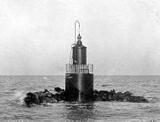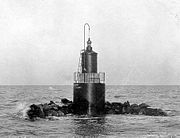
Pungoteague Creek Light
Encyclopedia
The Pungoteague Creek Light was a small screwpile lighthouse constructed in the Chesapeake Bay
in 1854. Destroyed in 1856, it had the shortest recorded existence of any lighthouse on the Bay, and possibly the United States
, at just 459 days.
The lighthouse was built just offshore from Accomack County, Virginia
, and was located near the mouth of Pungoteague Creek, then called the Pungoteague River. It was the first screwpile lighthouse built on the Chesapeake, and its construction was overseen by Major Hartman Bache
. Most of the foundation was prefabricated in Philadelphia, and was sent, along with the construction crew, down the Bay from Baltimore
on April 23, 1854. It was originally estimated that construction of the light would take only six weeks, but lengthy calms during the voyage combined with the crew's inexperience and difficulty in sinking the piles extended the process to almost six months.
The lighthouse was finished and commissioned on November 1, 1854. A small structure, it sat on seven pneumatic piles, and was equipped with a fifth-order Fresnel lens
. It was overturned by an ice floe on February 2, 1856. Nobody was injured as the lighthouse was close enough to shore to make rescue of the keeper
fairly easy; the structure, though, was a complete loss.
 Title was sought, and granted, for the construction of a new lighthouse, and $5,000 were set aside to cover costs. But it was soon decided that maritime traffic did not really justify the reconstruction of the tower, and the monies reverted to the Department of the Treasury
Title was sought, and granted, for the construction of a new lighthouse, and $5,000 were set aside to cover costs. But it was soon decided that maritime traffic did not really justify the reconstruction of the tower, and the monies reverted to the Department of the Treasury
. A privately maintained beacon was located at the same site until 1908, at which point an automated, flashing light on a concrete-filled caisson
was erected by the government for $8,000.
The destruction of the Pungoteague River Light led to further efforts being made to protect screwpile lighthouses with riprap
.
Chesapeake Bay
The Chesapeake Bay is the largest estuary in the United States. It lies off the Atlantic Ocean, surrounded by Maryland and Virginia. The Chesapeake Bay's drainage basin covers in the District of Columbia and parts of six states: New York, Pennsylvania, Delaware, Maryland, Virginia, and West...
in 1854. Destroyed in 1856, it had the shortest recorded existence of any lighthouse on the Bay, and possibly the United States
United States
The United States of America is a federal constitutional republic comprising fifty states and a federal district...
, at just 459 days.
The lighthouse was built just offshore from Accomack County, Virginia
Accomack County, Virginia
As of the census of 2010, there were 33,164 people, 15,299 households, and 10,388 families residing in the county. The population density was 84 people per square mile . There were 19,550 housing units at an average density of 43 per square mile...
, and was located near the mouth of Pungoteague Creek, then called the Pungoteague River. It was the first screwpile lighthouse built on the Chesapeake, and its construction was overseen by Major Hartman Bache
Hartman Bache
Hartman Bache was an American engineer who participated in the construction of many of the earliest lighthouses on the West Coast. He made a number of sketches of these lighthouses and light stations which have since become an important resource in the study of American lighthouses...
. Most of the foundation was prefabricated in Philadelphia, and was sent, along with the construction crew, down the Bay from Baltimore
Baltimore
Baltimore is the largest independent city in the United States and the largest city and cultural center of the US state of Maryland. The city is located in central Maryland along the tidal portion of the Patapsco River, an arm of the Chesapeake Bay. Baltimore is sometimes referred to as Baltimore...
on April 23, 1854. It was originally estimated that construction of the light would take only six weeks, but lengthy calms during the voyage combined with the crew's inexperience and difficulty in sinking the piles extended the process to almost six months.
The lighthouse was finished and commissioned on November 1, 1854. A small structure, it sat on seven pneumatic piles, and was equipped with a fifth-order Fresnel lens
Fresnel lens
A Fresnel lens is a type of lens originally developed by French physicist Augustin-Jean Fresnel for lighthouses.The design allows the construction of lenses of large aperture and short focal length without the mass and volume of material that would be required by a lens of conventional design...
. It was overturned by an ice floe on February 2, 1856. Nobody was injured as the lighthouse was close enough to shore to make rescue of the keeper
Lighthouse keeper
A lighthouse keeper is the person responsible for tending and caring for a lighthouse, particularly the light and lens in the days when oil lamps and clockwork mechanisms were used. Keepers were needed to trim the wicks, replenish fuel, wind clockworks and perform maintenance tasks such as cleaning...
fairly easy; the structure, though, was a complete loss.

United States Department of the Treasury
The Department of the Treasury is an executive department and the treasury of the United States federal government. It was established by an Act of Congress in 1789 to manage government revenue...
. A privately maintained beacon was located at the same site until 1908, at which point an automated, flashing light on a concrete-filled caisson
Caisson (engineering)
In geotechnical engineering, a caisson is a retaining, watertight structure used, for example, to work on the foundations of a bridge pier, for the construction of a concrete dam, or for the repair of ships. These are constructed such that the water can be pumped out, keeping the working...
was erected by the government for $8,000.
The destruction of the Pungoteague River Light led to further efforts being made to protect screwpile lighthouses with riprap
Riprap
Riprap — also known as rip rap, rubble, shot rock or rock armour or "Rip-rap" — is rock or other material used to armor shorelines, streambeds, bridge abutments, pilings and other shoreline structures against scour, water or ice erosion.It is made from a variety of rock types, commonly granite or...
.

